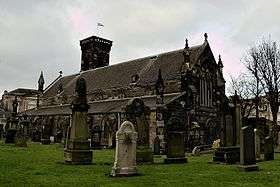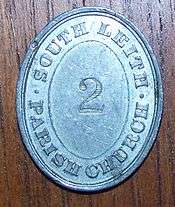South Leith Parish Church
| South Leith Parish Church | |
|---|---|
 The Constitution Street side of the church | |
| Coordinates: 55°58′19″N 3°10′22″W / 55.97194°N 3.17278°W | |
| Location | Between Constitution Street and the Kirkgate, near the bottom of the Leith Walk in Leith, Edinburgh's harbour district |
| Country | Scotland |
| Denomination | Church of Scotland |
| Website | http://www.slpc.co.uk/html/aboutus_church.html |
| History | |
| Former name(s) | St Mary's |
| Founded | 1487 |
| Architecture | |
| Status | Church |
| Functional status | Active |
| Heritage designation | Category A listed |
| Specifications | |
| Capacity | c.1400 |
| Materials | stone |
South Leith Parish Church, originally the Kirk of Our Lady, is a congregation of the Church of Scotland. It is the principal church and congregation in Leith, in Edinburgh. Its kirkyard is the burial place for John Home[1] (author of Douglas) and John Pew, the man from whom the author Robert Louis Stevenson reputedly derived the character of Blind Pew in the novel Treasure Island.[2] The church has been repaired, used as a magazine and reconstructed[3] but still looks similar to its appearance on a 1608 seal.[4]
History
The church has a long history although most of the visible building is more recent. The church began as a chapel dedicated to St Mary which was erected in 1483[5] and dedicated in 1487. (From the twelfth century South Leith had been part of the parish of Restalrig and had no church of its own.) As part of the dedication King James III of Scotland gave 18 shillings to the kirk.[3]
In 1544 the church was used as a refuge for people displaced by the fighting when the English attacked Leith as part of the Rough Wooing when the English attacked Scotland to try to encourage a marriage between the infant Mary, Queen of Scots and the English prince. Refuge was required as Henry VIII of England had ordered that Leith should be burnt. In the following year the Protestant martyr, George Wishart preached at the church and John Knox is thought to have been amongst those who came to listen. In 1547 the church was again involved in the struggle between the invading English and the Scots when the English used the church as a makeshift prison for Scottish nobles.[3]

In 1559, Mary of Guise, the regent of Scotland, worshipped at this church. Her coat of arms is displayed in the entrance of the church today.[1] Mary had fortified the town and she was in Leith being guarded by the thousands of French troops stationed here.[5]
Siege of Leith
In the following year, 1560, the English fleet and troops arrived at the invitation of Protestant Lords of the Congregation to lay siege to Leith in order that the French might be persuaded to leave.[6] The nave of this church had to be repaired due to damage caused by the English artillery. The French and the English troops did leave under the terms of the Treaty of Edinburgh. This agreement shifted the allegiance of Scotland from Catholic France to Protestant England.[6]
The consequences of the treaty and the peace that followed made enormous changes to the role of this church. Nearby Restalrig Church was the parish church. That church could trace its history back to events in the year 700 when Saint Rule and Saint Triduana had arrived in Scotland. Triduana had stayed on in Scotland and when she died the church of Restalrig was founded at that place. Now however feelings had changed and by the order of the General Assembly that church was razed to the ground and this church, although damaged, became the new church of the parish of Leith. The church became the de facto Parish Kirk for South Leith after Restalrig Kirk, which up until then had served that community, was demolished by order of the newly formed General Assembly.
The form of worship at the church was also changed in from Roman Catholic to Presbyterian, as a consequence of the Reformation. The church came under the ministry of David Lindsay who became the Bishop of Ross.
The new arrangement of power took time to settle down. In 1571 there was much discussion regarding the transfer of church positions. Noblemen were becoming bishops without any further qualification and positions in the church were being given to inappropriate people – including some who were still not legally adult.[7] In 1572 an "extraordinary" general meeting was called by the regent (the Earl of Mar) and held here.[3] The meeting made resolutions but they were not fully implemented as the King (James VI of Scotland was still a minor.[7]
The new status for South Leith Parish Kirk was confirmed by Act of Parliament in 1609. This was recorded in the parish records which still survive back to May 1597.[4] The seal of a charter granted in 1608 to a James Hall shows the church as being not dissimilar to its present appearance.[4] The kirk records record that in 1615 the church was added to with a central steeple.
In the middle of the 17th century the church was involved in initiating and supervising sanitary measures and relieving the distress of victims during the Plague of 1645. Over 2,700 people lost their lives – this was half the population. From 1650 to 1657 the Parliamentarians used the church as a magazine during the civil war.[8] The kirk records record the problems at that time with church services having to be conducted wherever space allowed.
From 1687 until 1692 the confirmation of the congregations as Presbyterian was demonstrated as the church expelled those who were Episcopalian.
18th and 18th Centuries
In 1766 the new minister was Henry Hunter who went on to publish sermons and more notably translate the work of leading French scientists.[9]

From 1824 until 1843 the minister was Rev James Grant (1800-1890) who came to later fame as the longest serving Director of Scottish Widows (1840 to 1890) and served as Moderator of the General Assembly of the Church of Scotland in 1854. During his ministry, in 1836 the central steeple that had stood since 1615 was dismantled. William Burn reported that this was essential as the steeple rested on the original west wall whilst the other newer walls had sunk and caused the tower to lean.[8] The present tower was not finished until 1848.
Disagreements within the congregation led to a split in 1843 when half the population led by a second minister formed a new church. However the church recovered and reconstruction (and restoration) of the building took place 1847–48 included the installation of a magnificent hammerbeam nave roof which was designed by the architect Thomas Hamilton.[5] The church is a category A listed building.[10] The roof design is said to be based on St Isaac's in St Petersburg. During this restoration the west window was salvaged and re-used at St Conan’s Kirk.[11]
In 1915 over 200 soldiers were killed and a similar number seriously injured in the Quintinshill rail disaster at Gretna.[12] The soldiers were from the 1st/7th Battalion, The Royal Scots (The Royal Regiment) which was a Territorial Battalion before Worl War I. The majority of the soldiers were recruited from Leith, with others recruited from nearby Musselburgh and Portobello. The Colours of this Battalion are still kept at the church in memory of the loss to the community. The soldiers are buried in Rosebank Cemetery in nearby Pilrig.
Location
South Leith Parish Kirk is situated on the Kirkgate in Leith, currently a pedestrian precinct. It sits within the parish which has been described as triangular having three main borders. On the west it borders the historic parishes of North Leith, Edinburgh and St Cuthbert's; on the south by Duddingston and Cannongate and the remaining border on the north east is the natural barrier of the Firth of Forth. Historically the parish covered about 2,200 acres (8.9 km2) but over time newer parishes have been identified within its borders as the surrounding population grew and rearranged.[4]

The church is home to the 10th Leith Boys Brigade Company and the Girl Guides. They meet at the church's halls in nearby Henderson Street.
Memorials
The graveyard or kirkyard is the burial place for the playwright John Home,[1] author of Douglas, and John Pew, the man from whom the author Robert Louis Stevenson reputedly derived the character of Blind Pew in the novel Treasure Island.[2] Pew was a maltman and was reputed to have had 25 children. Stevenson was related to the Balfour family so he may have seen the Pew grave whilst visiting the church of his family. Other notable people are Adam Whyte who was Leith's first Provost, Hugo Arnot, historian,[2] and John Hadaway, Lieutenant of the Bellerophon during the Battle of the Nile.
In the grounds of the graveyard are structures which contain memorials. The structures appear to have been roofed and to have had dividing walls and gates for each family's memorial. The gates, roof and walls are no longer present.
Ministry
The present Minister is the Rev Iain May BSc MBA BD who was inducted into the charge on 18 April 2012. The former minister (1995-2011) was the Reverend Ian Y. Gilmour, who was previously minister at Drylaw Parish Church in Edinburgh. On 28 April 2011 Mr Gilmour became minister at St Andrew's and St George's West Church in the centre of Edinburgh.
Notable former ministers include The Very Rev Dr John White, minister at South Leith 1904-1911, who would become Moderator of the General Assembly of the Church of Scotland in 1929.
See also
Sources
| Wikimedia Commons has media related to South Leith Parish Church. |
- 1 2 3 "South Leith Parish Church, Site Number NT27NE 30.0". CANMORE. RCAHMS. Retrieved 2009-05-26.
- 1 2 3 "South Leith Gravestones, LeithHistory.co.uk, 2003". Retrieved 2010-03-15.
- 1 2 3 4 Cast Iron sign in the grounds of the church, See illustration, accessed March 2010
- 1 2 3 4 5 Robertson,, D. (1911). South Leith Records p.42 et al (PDF). Edinburgh: Andrew Elliott.
- 1 2 3 "South Leith Parish Church". Gazetteer for Scotland. Retrieved 2010-03-15.
- 1 2 Knight, Charles (1857). The popular history of England, 3: an illustrated history of society and ... 3. Retrieved March 2010. Check date values in:
|access-date=(help) - 1 2 M'Crie, Thomas (1818). Life of John Knox. p. 198.
- 1 2 "South Leith Parish Church, Site Number NT27NE 30.0". CANMORE. RCAHMS. Retrieved 2010-03-15.
- ↑
 "Hunter, Henry". Dictionary of National Biography. London: Smith, Elder & Co. 1885–1900.
"Hunter, Henry". Dictionary of National Biography. London: Smith, Elder & Co. 1885–1900. - ↑ "South Leith Parish Church, Listed Building Report". Historic Scotland. Retrieved 2009-05-26.
- ↑ W. Swan, South Leith Records Second Series, (Leith, 1925), 290
- ↑ pictures of the Memorial at Rosebank to the officers and men who died in the Gretna Railway Disaster, accessed March 2010